Excerpts from Jim Conrad's
Naturalist Newsletter
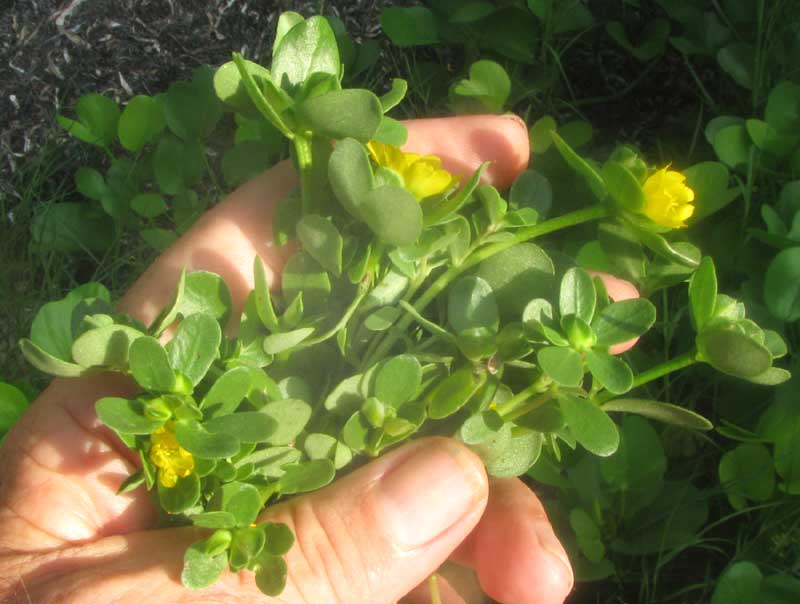
from the July 17, 2011 Newsletter issued from written at Mayan Beach Garden Inn 20 kms north of Mahahual; Caribbean coastal beach and mangroves, ~N18.89°, ~W87.64°, Quintana Roo state, MÉXICO
WILD PURSLANE'S OMEGA-3S & ANTIOXIDANTS
Several pretty colonies of Wild Purslane, PORTULACA OLERACEAE, recently appeared near our compost heap. Purslane, called Verdolaga here, is one of my favorite wild edible herbs, and lately I've been picking and eating my share. You can see a handful of sprouts above.
Wild Purslane flowers look like yellow buttercup blossoms, except that in the flower's center above the cluster of numerous male stamens the single style is topped by five or six long, slender, upward- and outward-arching, pollen-receiving stigmas, as seen below:
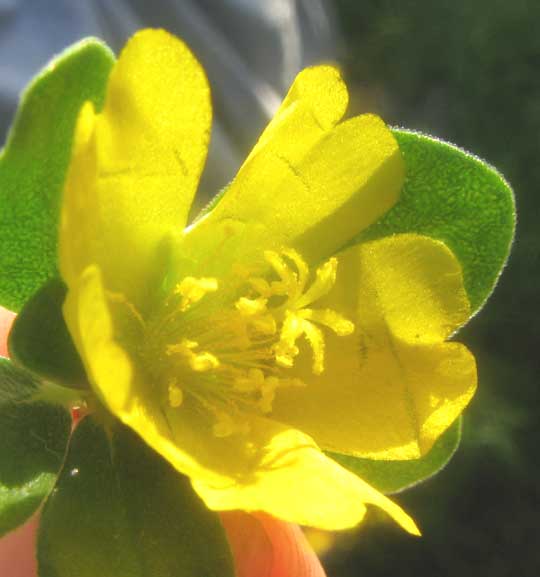
Here's something interesting: Wild Purslane contains the highest concentration of omega-3 fatty acids and antioxidants of any green leafy vegetable examined to date.
Cooking Wild Purslane is easy. Put a skillet with a little oil in the bottom over a fire and add about a gallon (4 liters) of leaves and stem tips. While being sautéed the leaves and stems lose maybe 80% of their bulk. Once they've cooked down you can eat them as-is or add something to them. I like to stir in two eggs. The end product tastes like eggs and spinach fried together. Onions, garlic, tomato, etc. can be added but I like the way simple, elemental flavors interact.
from the July 17, 2011 Newsletter issued from written at Mayan Beach Garden Inn 20 kms north of Mahahual; Caribbean coastal beach and mangroves, ~N18.89°, ~W87.64°, Quintana Roo state, MÉXICO
EATING WILD PURSLANE
I can't eat Wild Purslane without visualizing it coursing through my gastrointestinal tract releasing fatty-acid molecules and antioxidants like little spaceships -- spaceships deployed with missions to wander throughout my body and land here and there to perform critical maintenance. When I eat Wild Purslane, instantly I feel healthier and more alert. Of course that's psychological, but psychology counts. So much, I've found, boils down to how you feel about things, whether your feelings are rational or not.
When I eat Wild Purslane I develop a mental image of energy erupting from the Sun 93,000,000 miles away, shooting through empty space, and cascading onto Earth. Earth's photosynthesizing plants like Purslane capture the energy, mingle it with nutrients from Earth, water and air, and then make all that magical stuff freely available to other organisms, like me. During this transfer of energy from the Sun to ourselves, and mingling of the Earth's compounds with our own bodies, we various Earthly life forms are drawn into a special kind of community, a community with spiritual dimensions.
In fact, I regard meals such as my Wild Purslane with eggs as constituting nothing less than sacred communions during which I merge with the utterly generous and loving Universal Creative Spirit. Of course, the same feeling can arise from eating a Hostess Twinkie, for in the end a Twinkie's ingredients are natural, too, no matter how they've been processed and packaged by humans.
Still, when I eat wholesome Wild Purslane picked in the fresh air and sunlight and immediately prepared and eaten by myself, somehow the sense of communion is especially vivid.
from the January 8, 2017 Newsletter issued from Rancho Regensis north of Valladolid, Yucatán, MÉXICO;
elevation ~40m (~130 ft), N~20.876°, W~88.170°
GROWING PURSLANE TO EAT
The Maya workers scratched their heads when I started planting Common Purslane, which around here and throughout much of the hot to mostly-warm world is a common weed, even along sidewalks in towns. Traditionally, Purslane has been eaten by indigenous Americans for millennia, but nowadays here it's mostly forgotten as a good food, even as Northerners are beginning to "discover" it because of its nutritional value and good taste. The last time I was in Mexico City I bought a fistful from an indigenous lady selling it and other herbs from a tablecloth spread out on the sidewalk. When I was a kid on the farm in Kentucky it grew robustly in the rich soil around the barn where the animals pooped and I never heard of anyone eating it.
Below, you can see one of my two beds of Purslane:
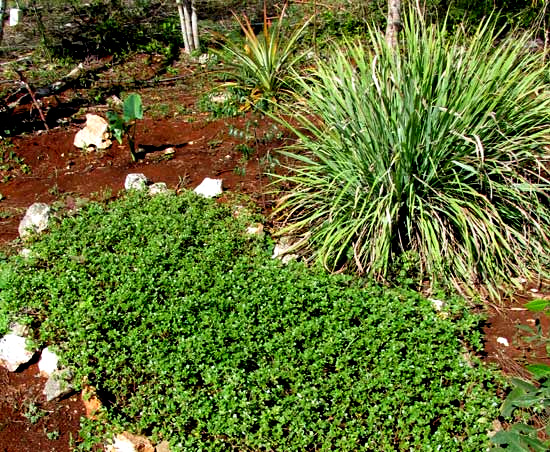
In that picture the big grass at the upper right is Lemon Grass supplying Lee's hotel guests with Lemon Grass tea. In the back, center, is a Pineapple plant, and to the left of the Pineapple the large-leafed plant is a Macal, a Maya cultivar of the big Elephant Ears ornamental plant.
The Purslane plants in my two beds grow fast and are especially succulent and good tasting because before planting the beds I worked in a good bit of cow manure, and I water the beds each day. I got the plants for setting by transplanting small plants from weedy spots. Below, you can see a typical weedy Purslane growing with other weeds beside an abandoned garden space:
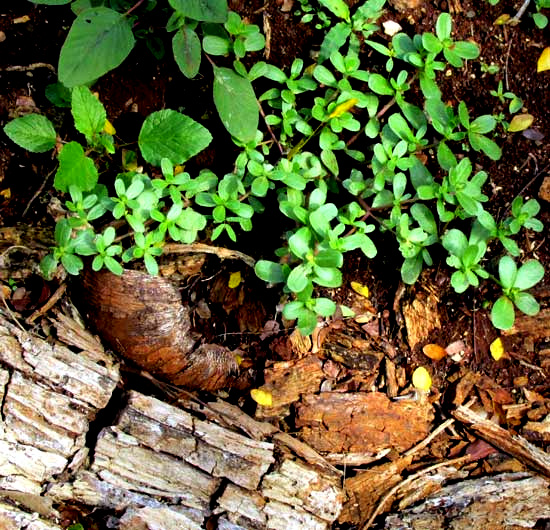
Purslane transplants well. Just pull them up and even if the roots come out without soil around them the plants quickly accommodate themselves to their new home if the soil is rich and moist.
Below, you can see what a morning breakfast's handful of freshly harvested Purslane from the garden looks like:

Below, you can see what the finished dish looks like, having started by sauteing half an onion and a jalapeño, then adding a chopped tomato and the above handful of Purslane, with the Purslane's stems included, contributing to the texture:

from the May 14, 2017 Newsletter issued from Rancho Regensis north of Valladolid, Yucatán, MÉXICO;
elevation ~40m (~130 ft), N~20.876°, W~88.170°
UPDATE ON GROWING PURSLANE TO EAT
Above, I show a bed densely populated with leafy plants perfect for eating. During this dry season's hotter months of March through May those plants eventually got "leggy" -- they developed thick stems with only a few small leaves at their tips, as shown below:
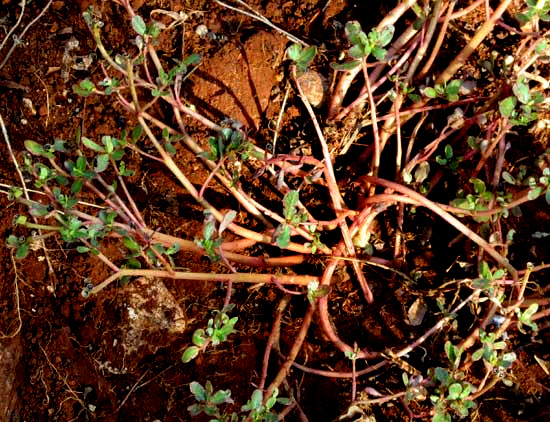
The stems are so soft and succulent that they can be cut into sections that are OK in stews and stir-fries, but I like stems with lots of leaves, thinking the leaves may be more nutritious.
Hoping to encourage new, leafy stems, I cut away the long, pink stems, but hardly any new growth resulted, even when the plants were watered generously each morning. Earlier the plants had produced many flowers and fruits, so the soil beneath the pink stems harbored untold numbers of seeds, and I wondered why they weren't germinating, producing new plants. In certain species, seeds only germinate on exposed soil, so I raked the soil where I'd cut away pink stems, but no new plants appeared, even with daily watering. I'm guessing that Purslane produces allelopathic compounds that retard the growth of other plants around it, including its own offspring, or maybe they don't germinate during such hot times as ours.
I'm unsure if this problem would have developed during the rainy season. Whatever the case, during the dry season the only way I've found to keep my Purslane beds full of leafy plants perfect for eating is to periodically go out and dig up small plants for transplanting to the beds. Below, you can see one such plant, its roots bringing along plenty of soil:
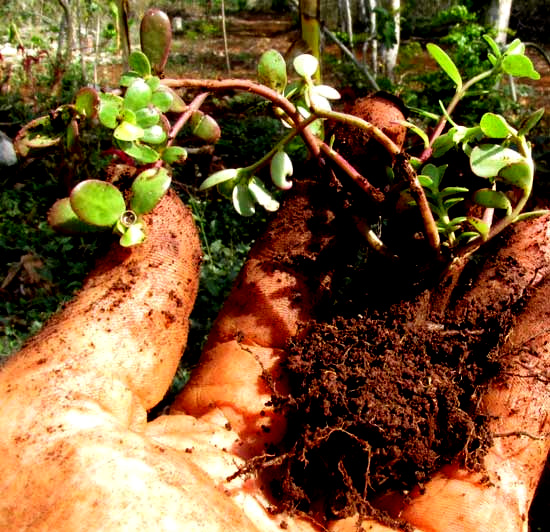
Purslane transplants wonderfully. A well rooted small plant like that shown above hardly shows any effect when transplanted, the very next day flowering brightly and bearing crisp and juicy leaves.
from the October 1, 2017 Newsletter issued from Rancho Regensis north of Valladolid, Yucatán, MÉXICO
GROWING PURSLANE UPDATE #2
In May I thought that lush beds of Purslane might be possible again, but when I went looking for wild plants to transplant, I couldn't find any. In the old Purslane beds where I knew the soil to be occupied with untold thousands of viable Purslane seeds, none were sprouting. Now as October begins, though it's even rainier now than in May, small Purslane seedlings are starting to emerge abundantly, as shown below:

To me it's a mystery why so many seeds, both of local plants and those brought from the North, may germinate prolifically most of the year, but refuse to do so from about June until October. Even Cilantro, or Coriander, which is one of the easiest of plants to germinate under many conditions, at that time just doesn't come up for me. I'm guessing that during the early rainy season pathogenic microbes undergo a population explosion and overwhelm most young plants, but by October -- though it's rainier than ever -- the soil ecosystem has had time to reach an equilibrium at which pathogens are equally matched by organisms favoring plant growth. That's just a guess.
Whatever the case, it's a pleasure to see the brave new crop of Purslanes volunteering in my garden, and I'm looking forward to scrambling them along with onions, chili and tomatoes into my eggs.
Entry issued on June 5, 2019, from the forest just west of Tepakán; elev. ~9m (~30 ft), N21.053°, W89.052°; north-central Yucatán state, MÉXICO
LUSH PURSLANE FROM DECAPITATED PLANTS
Upon arriving here, my friend Eric from Mérida presented me with an iguana-ravaged Purslane plant pulled from his garden, consisting of little more than the stem stubs the iguanas didn't care to eat. However, the plant had a good root system so I planted it and now in June have the lush plant shown below:
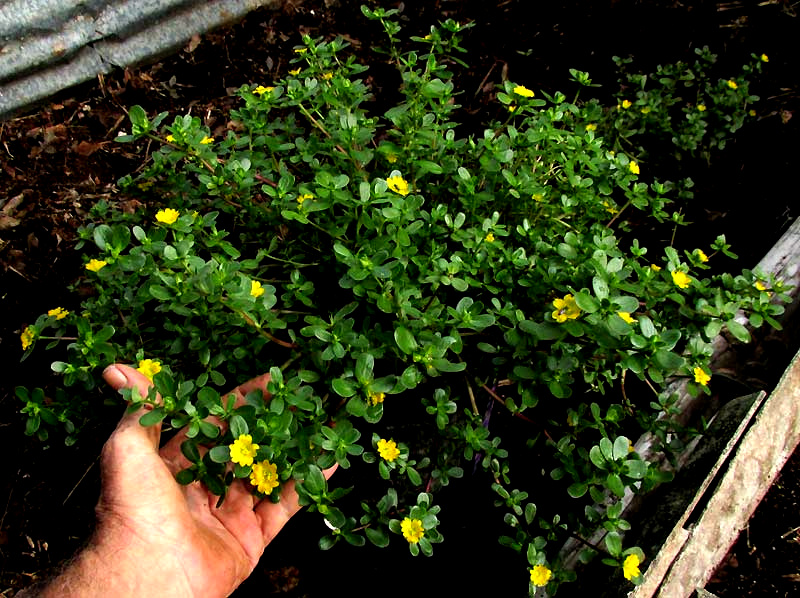
This shows that it's possible to have Purslane in good shape for eating when spring plantings have gotten "leggy." On leggy plants, cut the stems back to about finger length, and transplant into rich soil that's kept watered.
from the March 11, 2012 Newsletter issued from Hacienda Chichen Resort beside Chichén Itzá Ruins; limestone bedrock; elevation ~39m (~128ft), N20.675°, W88.569°; central Yucatán state, MÉXICO
PURSLANE'S TINY BOWLS
Now that the dry season is starting to bite, even semisucculent Purslane is dying back. You can see a sprout losing its greenness and withering below:
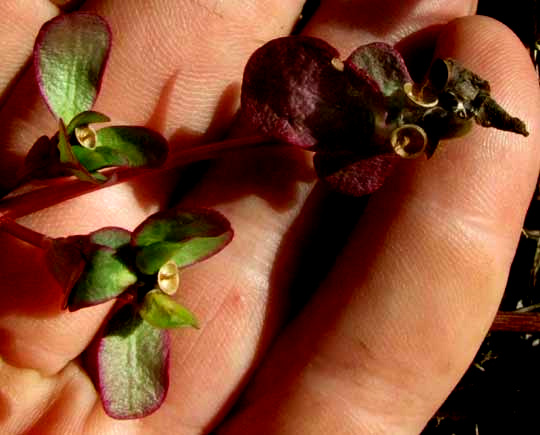
Normally one wouldn't bother to look at such a weather-beaten sprout, but I did, and what caught my eye were those pale little bowl-shaped things nestled among the withering leaves' bases. A close-up is shown below:
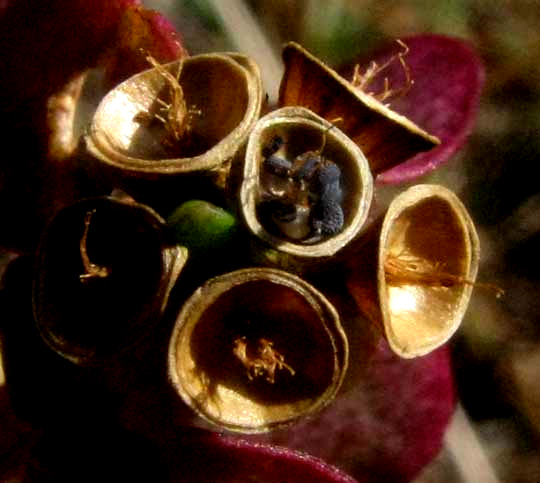
There you see the bottoms of some fruit pods, with the central pod holding several black, warty seeds. The tufts of slender items arising from the bottom of each fruit base are placenta-like funiculi which earlier connected the seeds with their ovary walls.
What's interesting about Purslane's fruit pod is that it splits around its equator, not between the fruit's base and tip as with most other fruits. Fruits opening this way are said to be "circumscissile." Once the fruit is mature, the top comes off like a pointed hat, leaving a "bowl" of seeds exactly as the picture shows.
What's the advantage of having a circumscissile fruit that creates a tiny bowl filled with seeds? I'm guessing that it's to facilitate seed dispersal by raindrops. A raindrop hitting inside the bowl would splash seeds in all directions.